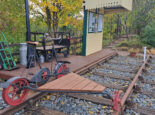Peterborough’s very own Green Backyard
[prev] …carnivorous water boatmen,’ says Sophie. Then there’s a large area planted up with perennial plants donated right at the start of the project by a keen gardener. ‘As well as attracting beneficial insects this area provides a calm and inspiring space. So while we’re not growing food in this part of the site, it serves a valuable purpose, offering somewhere people can wander and take time to look and enjoy the plants. Kids also love exploring or picking flowers with their parents.’
Fruit and veg
The main food growing elements of the GBY include of an orchard of apples, pears and gages. Most of the varieties are local and, while the trees are still very young, the first fruits have already been picked and enjoyed. Current winter staples include leeks, parsnips and winter salads, with the promise of rhubarb to follow in the next few months. Part of the vegetable garden is laid out as a Dig For Victory garden in a nod to the site’s significance during the war. Designed by college students, the garden features heritage varieties of vegetables and even has an Anderson Shelter built under guidance from older residents with first-hand experience of the Blitz.
Another area is given over to a local start-up called Local Roots. ‘They wanted to start up an organic salad business supplying local restaurants,’ explains Sophie. ‘They have been very successful indeed so we may well do something in partnership with them in the future.’ Some of the produce finds its way into the GBY’s shop, a new addition in May that will hopefully grow over time to produce an income for the group. ‘It’s housed in an old shipping container that was used for storage. We cleared it out, insulated it then cut windows into it. Volunteers fitted it out and it looks really lovely – very colourful.’ Located at the entrance, the shop sells organic foods and goods, including honey, jams and chutneys made by local people. It’s open whenever there’s activity on site, from 11am to 4pm on Wednesdays and Thursdays, then again at the weekend.
Major challenges
Sadly it hasn’t been – and still isn’t – plain sailing. A series of buildings housing a classroom, cook house, office and kitchen had to be torn down when an electric cable running beneath the site required essential maintenance. ‘It came as an incredible blow,’ says Rich. ‘Those buildings had been built by the community using recycled and donated materials. Many hours of hard work had gone into their construction. ‘But part of the beauty of the GBY is its resilience – staying in there and believing the project will bounce back. This year we’ve come back from that really difficult time.’ A replacement building known as The Hub was erected to house the new kitchen, work shop and meeting space. Like the buildings it replaces, much of The Hub uses recycled materials, including flagstones from Cathedral Square. Electricity for lighting is provided by solar panels, heating from a wood-burning stove, while composting toilets provide an ecological solution to the practical obstacle of a lack of mains water.
‘The possibilities for the site, however, are huge – once we are in a position to access funding. Our vision is to create a sustainable hub for the East of England…’
May saw a major push to tidy up and organise the site following the disruption of 2013, with help coming from local artists to give The Hub a facelift. ‘The Hub is a brilliant building,’ adds Sophie. ‘But we are limited by what we can do there. The possibilities for the site, however, are huge – once we are in a position to access funding. Our vision is to create a sustainable hub for the East of England. We’ll always remain a green space for the city, but the plan would be to build a proper café so we can really start promoting local food and a market around it. We also want to create a sustainably built and run visitor/education centre to give more flexibility in the courses we can offer.’

There are many activities which provide stimulation and new skills to Green Backyard visitors (shown: beekeeping)
Social impact
Many of the benefits that the GBY brings can’t be measured. First and foremost is its impact on people’s health, both physical and mental. ‘We get people involved who are recovering from depression,’ says Rich. ‘It’s an opportunity for them to be outdoors, to learn new skills and socialise – and we help many, many people that way. Then we have people who are recovering from major shocks. There’s a friend of mine whose dad recently had a stroke and lost the power of speech. He came to the GBY to work in the garden in his spare time and now he’s talking again. And he’s talking a lot more than before he lost the power of speech! ‘The elderly come too because they feel safe and they recognise the values of community that they might feel are under threat elsewhere. Then there are people from special needs schools. The GBY reaches out to so many different people and groups.’ ‘People find what they want here,’ adds Sophie. ‘For example, we had a guy who was off work with stress. He worked in tax and was in his fifties. He’d never really… [cont]
















